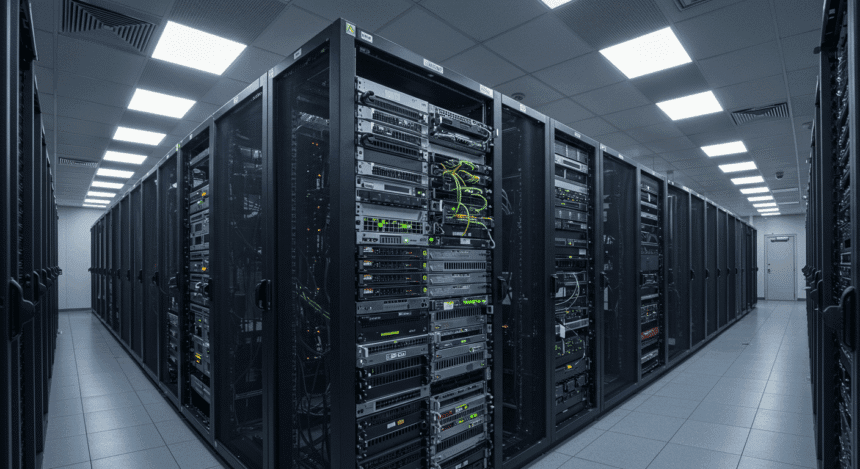We have talked a lot about the benefits of AI on Smart Data Collective, but we need to be real about some of the costs of it. The explosion of artificial intelligence adoption has triggered a massive appetite for computing resources across every industry. You can see it in the growing clusters of GPUs, the endless rows of servers, and the demand for faster cloud services. It is becoming clear that AI is not just a software revolution—it is a hardware one too.
A study by McKinsey and Company found that 78 percent of respondents say their organizations use AI in at least one business function. This number is rising rapidly as businesses explore new ways to automate decisions, enhance customer service, and process massive datasets. You might think this shift is purely digital, but behind every AI model lies a surge in physical computing requirements. It is a challenge many companies did not anticipate when they first started embracing machine learning. Keep reading to learn more.
Why AI Is Driving the Need for Dedicated Servers
Goldman Sachs Research forecasts that global power demand from data centers will increase 50 percent by 2027 and by as much as 165 percent by the end of the decade. You can already see the impact as utilities and data infrastructure providers scramble to expand capacity. It is the clearest sign yet that computing power has become a strategic necessity rather than a background operation.
The number of companies using AI has skyrocketed in just a few years, with more than 50% of firms employing over 5,000 workers adopting AI by early 2024. You might assume that cloud resources would keep up, but they are increasingly stretched thin under the growing computational load. It is often more practical for businesses to maintain dedicated servers that can meet their specific AI needs without depending on shared cloud limitations.
There are limits to how much virtualized environments can handle when it comes to AI workloads that require constant access to GPUs and high-memory systems. You can avoid latency, downtime, and resource throttling by investing in physical infrastructure. It is one of the few ways to ensure consistent model training speeds and faster deployment cycles across departments.
A report by the International Energy Agency revealed that, due to rising data processing demands, the U.S. economy is set to consume more electricity in 2030 for handling data than for manufacturing. You can interpret that as a sign of how digital power has overtaken traditional industry as the primary economic driver. It is also a warning that businesses relying on AI need to think carefully about their infrastructure footprint and long-term energy costs.
There are many advantages to owning dedicated servers in this new environment. You gain direct control over security, uptime, and scalability without the hidden fees that often accompany cloud services. It is also easier to predict performance since your resources aren’t shared with other clients running unrelated workloads.
You might assume that large companies are the only ones facing this issue, but even mid-sized firms are feeling the crunch. There are few AI workflows that don’t rely on intensive data training or real-time analytics anymore. It is often during scaling that teams discover how quickly cloud costs can surpass the predictable expense of maintaining a dedicated system.
The rise in computing demand is not slowing down anytime soon. You can expect energy and hardware pressures to climb as AI models become more complex and integrated into daily operations. It is already clear that businesses need to plan for long-term data management and power resilience instead of treating AI as just another software upgrade.
Your company’s server infrastructure determines how fast applications run, how many users can access services simultaneously, and how secure your data remains. While shared hosting and virtual private servers work for smaller operations, businesses reaching certain thresholds need the full resources and control that dedicated servers provide. Here are five specific reasons why switching to dedicated hardware makes sense for growing companies.
Full Processing Power Without Competition
Dedicated servers give you exclusive access to all CPU cores, RAM, and storage on the machine. On shared hosting, your website might have access to 2GB of RAM one moment and find itself throttled to 512MB the next when other sites on the same server start consuming resources. This unpredictability vanishes with dedicated hardware.
Consider an e-commerce platform during Black Friday sales. On shared hosting, the surge in visitor traffic could cause page load times to increase from 2 seconds to 8 seconds or more. Studies show that 40% of users abandon websites that take longer than 3 seconds to load. With a dedicated server running the same platform, those load times remain consistent because no other websites are pulling from your processor or memory pool.
When Shared Resources Create Bottlenecks
Growing businesses often start with shared hosting plans where multiple websites compete for the same server resources. This arrangement works until traffic spikes or resource demands increase, causing slowdowns that affect every process from database queries to file transfers. Companies running resource-intensive applications face similar constraints with virtual private servers, cloud instances, and dedicated server hosting options each offering different levels of resource isolation.
The bottleneck effect becomes apparent when examining server response times during peak hours. A company processing financial transactions might see query times jump from milliseconds to full seconds when neighboring accounts on shared infrastructure consume excessive bandwidth or processing power. These delays compound across interconnected systems, turning minor slowdowns into operational problems that affect customer transactions and internal workflows.
Complete Control Over Server Configuration
Dedicated servers let you install any operating system, software stack, or custom applications your business requires. You can run Windows Server 2022 with specific .NET framework versions, or deploy a stripped-down Linux distribution optimized for your particular workload. Shared hosting locks you into predetermined configurations that might force compromises in your technology choices.
A medical imaging company, for example, might need specialized GPU drivers for processing CT scans. Installing these drivers requires root access and kernel modifications that shared hosting providers won’t permit. The same company might also need to run proprietary analysis software that requires specific library versions incompatible with standard hosting environments. Dedicated servers remove these restrictions entirely.
Security Through Physical Isolation
Your data sits alone on dedicated hardware, eliminating risks from neighboring accounts. Shared servers face cross-contamination threats where vulnerabilities in one customer’s code can potentially expose other sites on the same machine. In 2019, researchers discovered the “Side-Channel Attack” vulnerability that allowed malicious actors to extract encryption keys from virtual machines sharing the same physical processor.
Financial services companies handling payment card data must comply with PCI DSS requirements, which become easier to meet when you control the entire server environment. You can implement hardware-based encryption, configure custom firewall rules at the kernel level, and ensure that audit logs capture every system event without interference from other tenants’ activities.
Predictable Performance Metrics
Dedicated servers deliver consistent response times that you can measure and guarantee to customers. A video streaming service knows exactly how many concurrent streams their dedicated server can handle because the hardware specifications remain constant. They can promise 4K streaming to 500 simultaneous users because they’ve tested that exact scenario on their dedicated hardware.
Performance monitoring becomes straightforward when you’re tracking a single tenant. You can identify memory leaks in your application code rather than wondering if slowdowns come from external factors. Database optimization efforts show immediate, measurable results since query execution times depend solely on your configuration and workload.
Direct Hardware Access for Specialized Needs
There are few moments in technological history when demand has outpaced infrastructure as quickly as with AI. You can see it in the skyrocketing data center power projections and the sheer volume of computing cycles now devoted to model training. It is not simply about having the latest hardware—it’s about ensuring that infrastructure can sustain tomorrow’s workloads.
You can take proactive steps now by exploring dedicated servers that match your company’s scale and goals. It is a forward-looking decision that helps balance performance, security, and cost in an era where AI isn’t just changing how businesses operate—it’s redefining what kind of computing they need to survive.
Some businesses require specific hardware configurations that shared environments cannot provide. A machine learning startup might need servers with multiple NVIDIA A100 GPUs for training neural networks. Audio production companies might require servers with specialized sound cards for real-time processing. Gaming companies often need servers with high-frequency CPUs optimized for single-threaded performance rather than multi-core throughput.
Dedicated servers also allow physical hardware additions and modifications. You can add RAID controller cards for redundant storage, install 10-gigabit network interfaces for faster data transfer, or connect external storage arrays for expanded capacity. These hardware-level customizations remain impossible in shared or virtualized environments.
The decision to move to dedicated servers depends on your specific performance requirements, security needs, and growth projections. Companies processing sensitive data, running resource-intensive applications, or requiring guaranteed performance levels will find that dedicated servers solve problems that other hosting options cannot address. The higher monthly cost translates into predictable performance, complete control, and the elimination of resource competition that constrains business operations on shared infrastructure.











